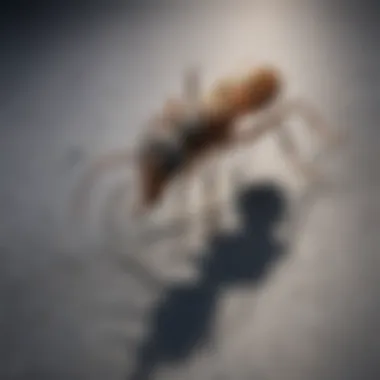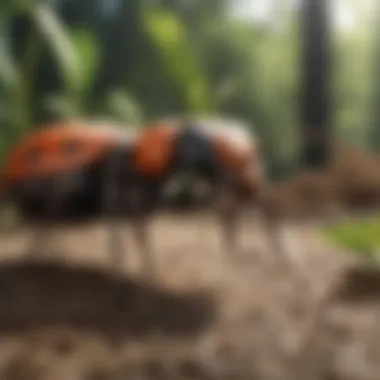Cost Analysis of Ant Spraying in Pest Control


Intro
Ants, despite their small size, can be a significant nuisance in homes and gardens. Understanding the economics behind ant control is crucial for homeowners seeking to manage these pests effectively. This article explores the cost analysis of ant spraying, elucidating on the factors that determine pricing and the overall value of pest control services.
In this examination, we will delve into various aspects that contribute to the cost of ant spraying. These include service variations, average pricing across regions, and potential additional fees that might arise. Moreover, the importance of correct pest identification will be discussed to aid in choosing the best control methods.
The article serves as a guide for diligent homeowners and gardening enthusiasts who wish to make informed decisions, balancing cost with effective solutions. A comprehensive understanding can lead to better pest management strategies that consider both financial and environmental factors.
Understanding Pests
Ants, particularly when they invade living spaces, require prompt attention. They can disrupt daily life and damage property. However, before taking any action, it is imperative to understand what qualifies as a pest.
Definition of Pests
Pests are organisms that adversely affect human activities. In this context, ants not only invade homes but can also harm gardens and landscaping. Understanding the types of ants present in your area can aid in effective management.
Importance of Pest Identification
Identifying specific ant species is crucial before implementing control measures. Some ants might be harmless, while others may create colonies in walls or structures, leading to costly repairs. Thus, proper identification can result in more focused and efficient treatment options, ultimately saving money.
Prevention Techniques
Preventing an ant infestation is often more cost-effective than treatment. Therefore, homeowners should consider various techniques to deter these pests before they become a problem.
Home and Garden Preventative Measures
- Seal Entry Points: Inspect homes for cracks and gaps. Sealing these can prevent ants from entering.
- Keep Areas Clean: Regularly clean food debris and spills in kitchens and dining areas.
- Manage Waste Properly: Use tightly sealed containers for garbage to deter food searching ants.
Seasonal Prevention Tips
- Spring Cleaning: With warmer weather, conduct thorough cleanings and inspect for any new entry points.
- Mulching: For gardens, use non-attractive materials for mulch to discourage nesting.
Eco-Friendly Pest Control Solutions
Sustainability in pest management has gained traction. Many homeowners prefer eco-friendly methods to protect their structures without harming the environment.
Overview of Sustainable Practices
Using integrated pest management strategies can help to balance ecological health with effective pest control. This approach often includes the use of compounds that are less harmful than traditional pesticides.
Natural Remedies and Their Effectiveness
- Vinegar Solutions: Mixing equal parts water and vinegar can repel ants due to the strong scent.
- Boric Acid: A natural ant bait that disrupts their feeding pattern. Care must be taken to keep this away from pets and children.
Choosing the right pest control solution not only addresses the immediate concern but also considers long-term effects on health and the environment.
In summary, understanding the costs associated with ant spraying, preventive measures, and eco-friendly solutions allows homeowners to make informed choices in pest control. This knowledge can lead to significant savings and a healthier living environment.
Prologue to Ant Infestations
Ant infestations can become a significant concern for homeowners. The presence of ants can indicate underlying issues regarding sanitation or structural integrity. Understanding the basics of ant behavior and their nesting patterns is crucial. This knowledge empowers homeowners to respond effectively to ant problems.
Knowing which species are infesting a property can direct pest control efforts. Different species exhibit varied behaviors and nesting preferences. This allows for more targeted and effective treatments. Moreover, a comprehensive grasp of ant activity can help prevent future infestations.
An early detection of infestations can lead to simpler and more affordable solutions. While some might think ants are harmless, they can damage food sources and compromise hygiene. Thus, timely action is necessary.
Understanding Ant Species
Ants belong to a diverse group with over 12,000 identified species worldwide. Common types include Carpenter ants and Odorous house ants. Carpenter ants can cause structural damage as they excavate wood for nesting. On the other hand, Odorous house ants are often associated with food contamination, as they invade kitchens in search of sweets. It is vital to accurately identify these species first. Each has distinct characteristics and treatment methods. The identification process can range from observing their color and size to noting their movement patterns.


Common Signs of Ant Infestation
Recognizing signs of ant infestations can help address problems early. Homeowners should look for the following:
- Visible Trails: Ants often follow pheromone trails. Spotting a line of ants moving in and out is a tell-tale sign.
- Nesting Areas: Finding small mounds of soil or entry points near walls can indicate nests.
- Food Contamination: Discovered ants in food storage areas suggest they are foraging.
- Presence of Winged Ants: During mating season, winged ants appear. Their presence often points to established colonies nearby.
Proper monitoring and understanding of these signs can simplify pest control efforts and minimize costs associated with treatment.
Assessing the Need for Spraying
Understanding when to spray for ants is essential for effective pest control. Assessing the need for spraying helps home and property owners make informed decisions. It focuses on evaluating both the severity of the issue and the origin of the infestation. Recognizing these aspects can prevent unnecessary treatments, save costs, and also reduce chemical exposure in the home environment.
Evaluating the Severity of the Problem
To evaluate the severity of an ant problem, one must first recognize the signs of infestation. Sightings of ants in common areas, along with trails leading to food sources, signal a growing issue. In some cases, the species of ant can inform the level of concern. For instance, carpenter ants may cause structural damage, while sugar ants might primarily be a nuisance.
Another aspect to consider is the size of the infestation. A few ants may not warrant immediate action, but larger colonies can multiply rapidly. Homeowners should carefully observe ant behavior. Consistent movement and the presence of multiple nest sites indicate a more severe problem that likely requires intervention.
Benefits of Assessing Severity:
- Helps homeowners avoid premature spraying, which may not solve the problem.
- Provides insight into whether professional assistance is necessary, potentially saving money.
- Allows for targeted solutions rather than blanket treatments.
Identifying the Source of Infestation
Identifying where ants are coming from is crucial. This can involve inspecting both the interior and exterior of a property. Common entry points include gaps around doors, cracks in foundations, and spaces around windows. Once located, sealing these areas can significantly reduce the chances of future infestations.
Furthermore, understanding what attracts ants is vital. Food sources such as trash, pet food, and spilled liquids can draw them in. Homeowners should assess their surroundings for such attractants and remove them as a preventive measure.
This process also demands looking for ant nests. Nests may be located in walls, soil, or even under debris outside. Discovering the nest allows for a more effective treatment plan, focusing efforts directly at the source rather than just at the visible ants.
Conclusion of Assessing:
Evaluating the severity and identifying the sources play a central role in determining whether spraying is necessary. Such diligence can lead to more effective pest management strategies and ultimately save time and resources in the long run.
Factors Influencing Spraying Costs
Understanding the factors that influence the cost of ant spraying is crucial for homeowners. This knowledge helps in making informed financial decisions. Various elements can affect pricing, including the type of treatment used, the size of the area needing treatment, and the frequency of treatments required. Grasping these factors allows consumers to anticipate costs and determine the most effective pest control strategy.
Type of Treatment Used
The selection of treatment type is a primary determinant of the overall cost. There are several approaches to ant extermination, with chemical sprays and eco-friendly solutions being common choices. Chemical treatments often provide quick results but may come at a higher price due to the potency and regulatory compliance required for their use. In contrast, organic or eco-friendly options may be less costly initially but could require more frequent applications. Homeowners should assess their priorities—whether they value effectiveness or environmental impact more—to choose the right treatment.
Size of the Area to be Treated
The dimensions of the affected area also significantly influence the price of ant spraying. Larger homes or properties will naturally incur higher costs, as more product is needed and more time is required for effective application. For instance, a small apartment may need only a minimal fee, while a sprawling estate could necessitate a comprehensive analysis and a multi-step treatment plan. Homeowners should engage pest control professionals to obtain accurate estimates based on the specific size and layout of their property.
Frequency of Treatment Required
Another essential factor is how often treatments must be administered. Some ant infestations may resolve after a single application, while others may require ongoing management with multiple visits. The type of ant and severity of the infestation can dictate whether a one-time treatment is sufficient or if a long-term plan is necessary. Costs will vary according to the lens of service; therefore, understanding the long-term implications is essential. Engaging with pest control providers will help clarify your unique situation regarding the needed frequency of treatment.
"A well-informed homeowner can navigate the complexities of pest control pricing with greater ease, ultimately saving time and money."
In summary, considering these factors—type of treatment, size of the area, and the frequency of treatments—can significantly aid in assessing the cost of ant spraying. Homeowners are encouraged to conduct thorough research and consult experts when planning pest control measures.
Average Costs for Ant Spraying
Understanding the average costs for ant spraying is essential for homeowners facing infestations. This section provides insight into what you can expect to pay for pest control services and why it's vital to know these figures. By grasping the average costs, homeowners can make informed decisions, budget accordingly, and understand the value offered by professional pest control providers.
Typical Price Range


When it comes to typical pricing, the costs for ant spraying can vary widely depending on several factors. Typically, homeowners can expect to pay around $100 to $300 for a single treatment. This price often includes an initial assessment, the spraying itself, and sometimes follow-up visits.
- Factors affecting pricing:
- Type of ant species involved.
- Size of the area to be treated.
- Complexity of the infestation.
Some services may offer package deals that include multiple visits at a lower cost per treatment, which can be beneficial if the problem requires ongoing management.
Regional Variations in Pricing
Pricing for ant spraying can exhibit regional variations due to a variety of influences, including local demand, cost of living, and the availability of pest control services. In urban areas, for instance, the costs may be higher due to increased expenses associated with running a business in a city compared to rural areas.
- High-cost regions:
- Lower-cost regions:
- New York City
- San Francisco
- Midwest states
- Southern rural areas
Understanding these regional disparities in pricing helps homeowners better anticipate the costs they might incur in different locations, ensuring they choose a service that fits within their budget.
Comparing DIY Solutions to Professional Services
When dealing with ant infestations, homeowners often face a critical decision between tackling the problem themselves or hiring professional pest control services. Understanding the differences in effectiveness, costs, and overall value of DIY methods versus professional services is essential for making an informed choice.
Advantages of Professional Pest Control
One of the most significant benefits of hiring professional pest control services is their expertise. Trained technicians can identify ant species accurately, assess the level of infestation, and deploy appropriate treatment methods tailored for specific situations. They use commercial-grade products that might not be available to the general public, ensuring a more effective eradication of pests.
Another advantage is the safety aspect. Pest control professionals follow strict safety regulations and possess the necessary protective gear, minimizing risks associated with the application of chemicals. They also provide guidance on preventive measures to avoid future infestations, contributing to long-term effectiveness.
In addition, many pest control companies offer guarantees or warranties on their services, providing peace of mind. If ants return within a specified period, they may offer follow-up treatments at no additional cost.
Cost Implications of DIY Methods
While DIY solutions can seem cost-effective upfront, several factors must be considered before proceeding with them. The initial purchase price of over-the-counter pest control products can be lower than hiring professionals. However, effectiveness may vary. Often, these solutions only provide temporary relief and do not address the root cause of the infestation.
Moreover, there is a risk of overspending on multiple products as homeowners test various treatments without achieving desired results. In some cases, the ant problem may worsen, leading to a more expensive professional treatment later.
"Understanding the true cost of DIY pest control can save homeowners from unforeseen expenses."
Hidden Costs Associated with Ant Spraying
Understanding the hidden costs associated with ant spraying is crucial for homeowners contemplating pest control solutions. These costs, often overlooked, can significantly impact the overall expenses incurred in managing ant infestations. Hidden costs may include ongoing maintenance fees and various environmental charges that collectively influence the economic viability of pest control services.
Post-Spraying Maintenance Fees
Once the initial spraying is completed, homeowners must consider the necessity of post-spraying maintenance. These fees can arise from follow-up treatments that ensure the effectiveness of the initial application. Weather conditions, the severity of the infestation, and the species of ants targeted can all dictate the frequency of these maintenance check-ups. Failing to schedule these treatments may lead to a resurgence of the problem, incurring greater costs in the long run.
Homeowners should inquire about the specific policies pest control companies have regarding maintenance fees. Often, these charges are not included in the original agreement. Instead, they represent an additional financial commitment that may catch consumers off guard.
"Understanding the long-term commitment to pest control is essential. Not inquiring about maintenance fees can result in unexpected expenses later."
Environmental Impact Fees
Another hidden cost category pertains to environmental impact fees. Many pest control companies are now required to comply with regulations that address the ecological effect of chemical treatments. This compliance can lead to additional charges that vary by region.
For homeowners, factor in these potential environmental fees when evaluating pest control choices. Such fees reflect the company’s commitment to using eco-friendly products or adhering to regulations surrounding chemical use. Homeowners may prefer companies that implement sustainable practices, but this often comes with increased costs.
In contrast, opting for more chemical-intensive treatments might reduce upfront costs but lead to hefty fines for environmental damages later. Making an informed decision about these hidden costs is crucial for the upkeep of both the property and the surrounding environment.


Evaluating Long-Term Value of Spraying
Evaluating the long-term value of spraying for ants is crucial for homeowners considering pest control options. The decision to invest in such services should not be limited to immediate costs, but rather encompass the broader picture, including the effectiveness, sustainability, and potential repercussions on property value. Long-term efficacy of ant spraying can often mean the difference between a one-time fix and ongoing pest issues, impacting both finances and home comfort.
Cost-Benefit Analysis of Treatment Options
When it comes to ant control, weighing the costs against the benefits can guide effective choices.
- Upfront Costs: Professional spraying may be seen as expensive initially, but the quality of service often justifies this. A more thorough treatment can prevent future infestations, leading to longer-term savings.
- Effectiveness and Safety: Professional exterminators use industry-grade products that deliver superior results. This can minimize health risks associated with lesser known DIY methods.
- Time Savings: Professionals can often complete the job in a fraction of the time it might take an individual. This frees up homeowners to attend to other priorities.
- Post-Treatment Services: Some pest control companies offer follow-up inspections and maintenance. This can further ensure the effectiveness of the treatment, reducing the chance of re-infestation.
In conducting this analysis, it's essential for homeowners to consider their specific situation. For example, if an infestation is severe, the upfront costs of professional services might be much lower in comparison to ongoing damage and inconvenience.
Impact on Property Value
The implications of ant infestations extend beyond mere inconvenience. They can significantly affect property value:
- Perceived Value: Properties known to have pest issues may face lower market values. Buyers tend to view previous infestations warily, often assuming ongoing problems.
- Repair Costs: In extreme cases, ant infestations can lead to structural damage. Repairing this can be costly and would directly affect the property’s value.
- Home Sales: When selling a home, having a documented pest control history may attract potential buyers and enhance selling prospects. This documentation can showcase proactive measures taken to maintain the property.
This long-term evaluation emphasizes the resolution of ant issues now rather than postponing, ultimately supporting a home’s structural integrity and marketability.
Consumer Rights and Pest Control Contracts
Understanding consumer rights in the context of pest control contracts is essential for homeowners seeking effective ant spraying solutions. It helps ensure that clients know their entitlements when engaging pest management services. Knowing these rights affords them an upper hand in navigating agreements and ensures transparency in the services provided.
One significant aspect of consumer rights relates to service agreements. These are contracts that define the responsibilities of pest control companies and the expectations of homeowners. Homeowners should thoroughly read and comprehend these agreements before signing. The contract should explicitly outline the scope of the service, including the methods used and duration of treatment. It is also crucial to verify the licenses and certifications of the pest control provider, ensuring they comply with local regulations. Proper due diligence can prevent potential issues while providing a solid foundation for the relationship between the consumer and service provider.
Understanding Service Agreements
Service agreements play a pivotal role in pest control engagements. These documents specify what services the provider will deliver, including terms and conditions regarding treatment effectiveness. Homeowners must recognize that they are not merely purchasing a service; they are entering a legal agreement that protects both parties.
- Key elements to look for in service agreements include:
- Detailed Description of Services: The agreement must clearly outline what treatments will be applied and the products used.
- Duration of Service: Homeowners should know how long treatments are expected to last and how frequently follow-up services will occur.
- Cancellation Policy: It's important to understand the terms of cancellation, including any potential fees or penalties.
In essence, homeowners need to ensure their rights are well-represented in any service agreement. Failure to do so may result in unexpected charges or incomplete services.
Guarantees and Warranties
Another crucial consideration in pest control contracts is guarantees and warranties. Most reputable pest control companies offer some form of guarantee for their services. This could relate to the effectiveness of ant spraying or any follow-up treatments needed. Knowing the specifics of these guarantees helps consumers assess the value of the service they are purchasing.
- When evaluating guarantees, homeowners should ask the following:
- What does the guarantee cover? Ensure clarity on what aspects of the service are guaranteed.
- For how long is the guarantee valid? A commitment for several months is preferable, indicating confidence in the product and service.
- What are the conditions for claims? Understand any circumstances under which the guarantee may become void, such as homeowner negligence or lack of proper maintenance.
In summary, comprehending consumer rights, service agreements, and the nature of guarantees can empower homeowners. With clarity and knowledge, they can engage pest control services with confidence, ensuring that their needs are met and their rights upheld.
Ending: Making Informed Decisions
Making informed decisions regarding ant spraying is crucial for homeowners. This aspect is not merely about eradicating pests but also about understanding the financial implications and long-term benefits tied to pest control choices. When confronted with an ant infestation, having a comprehensive grasp of potential costs, benefits, and the local market can significantly influence outcomes.
In essence, weighing costs against benefits becomes paramount. An individual must assess whether the expenditure on ant spraying translates into effective pest management and whether it addresses the root cause of the infestation. For example, one might consider the longevity of the protective effects offered by a professional treatment versus the recurring costs of DIY methods. Evaluating these factors can guide homeowners in making choices that align with their circumstances.
Weighing Costs Against Benefits
When considering ant control, the costs involved should be carefully examined against the expected benefits. This involves analyzing not only the immediate financial outlay but also the longer-term effects on the property and overall well-being. Homeowners should ask themselves a few key questions:
- What is the expected lifespan of the treatment?
- How often will retreatment be necessary?
- Will this service add value to my property?
Additionally, one might consider potential damage from increased infestations if left untreated. Ants can undermine structures or contaminate food sources, leading to more substantial costs in repairs or health risks over time. Thus, recognizing the long-term effects can help justify the investment in professional ant spraying services.
Selecting the Right Pest Control Provider
Choosing a suitable pest control provider is integral to ensuring effective ant management. Not all services are created equal, and the right provider can mean the difference between a successful eradication and ongoing pest issues. Here are some essential factors to consider:
- Experience and Reputation: Review potential providers for their history in pest management. Look for testimonials or feedback from previous customers.
- Service Options: Ensure they offer various treatment methods, including eco-friendly options, if that is a concern.
- Warranty or Guarantee: A reputable company should provide assurances on their work, which can add a layer of security to your investment.



